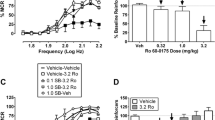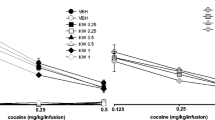Abstract
MK-801 is a ligand at phencyclidine recognition sites associated with NMDA-coupled cation channels, where it acts as a potent noncompetitive antagonist of central glutamate/aspartate (NMDA-type) receptors. Low doses (10–100 μg/kg IP) produced a dose-related and prolonged (>1 h) enhancement of variable-interval self-stimulation responding. Higher doses (300 μg/kg) caused flaccid ataxia and disrupted responding. Ketamine HCl (3.0–100 mg/kg IP), a dissociative anaesthetic binding to the phencyclidine site, produced a similar response pattern, but facilitation was less prolonged and occurred over a narrower dose range. Kynurenic acid (3.0–300 mg/kg IP), a nonselective competitive antagonist of glutamate receptors, produced only depression of responding, possibly the result of kynurenate-induced blockade of central kainate and/or quisqualate receptors. The behavioural stimulant effects of MK-801 appear to be an intrinsic and essential feature of selective NMDA antagonists, and these effects of MK-801 differ qualitatively and quantitatively from the well-known facilitatory effects of dopamine-dependent stimulants.
Similar content being viewed by others
References
Anis MA, Berry SC, Burton NR, Lodge D (1983) The dissociative anaesthetics, ketamine and phencyclidine, selectively reduce excitation of central mammalian neurones by N-methyl-aspartate. Br J Pharmacol 79:565–575
de Belleroche JS, Rose FC (1987) Zinc, glutamate receptors, and motoneurone disease. Lancet II:1082–1083
de Belleroche JS, Recordati A, Rose FC (1984) Elevated levels of amino acids in the CSF of motor neurone disease patients. Neurochem Pathol 2:1–6
Benvenga MJ, Spaulding TC (1988) Amnesic effect of the novel anticonvulsant MK-801. Pharmacol Biochem Behav 30:205–207
Boldry RC, Uretsky NJ (1988) The importance of dopaminergic neurotransmission in the hypermotility response produced by administration ofN-methyl-d-aspartic acid into the nucleus accumbens. Neuropharmacology 27:569–577
Bridges RJ, Geddes JW, Monaghan DT, Cotman CW (1988) Excitatory amino acid receptors in Alzheimer's disease. In: Lodge D (ed) Excitatory amino acids in health and disease. Wiley, New York, pp 321–335
Clineschmidt BV, Martin GE, Bunting PR (1982a) Anticonvulsant activity of (±)-5-methyl-10,11-dihydro-5H-dibenzo-[a, d]cyclohepten-5,10-imine (MK-801), a substance with potent anticonvulsant, central sympathomimetic, and apparent anxiolytic properties. Drug Dev Res 2:123–134
Clineschmidt BV, Martin GE, Bunting PR, Papp NL (1982b) Central sympathomimetic activity of (±)-5-methyl-10,11-dihydro-5H-dibenzo-[a, d]cyclohepten-5,10-imine (MK-801), a substance with potent anticonvulsant, central sympathomimetic, and apparent anxiolytic properties. Drug Dev Res 2:134–145
Clineschmidt BV, Williams M, Witoslawsky JJ, Bunting PR, Risley EA, Totaro JA (1982c) Restoration of shock-suppressed behavior by treatment with (±)-5-methyl-10,11-dihydro-5H-dibenzo-[a,d]cyclohepten-5,10-imine (MK-801), a substance with potent anticonvulsant, central sympathomimetic, and apparent anxiolytic properties. Drug Dev Res 2:147–163
Danysz W, Wroblewski JT, Costa E (1988) Learning impairment in rats byN-methyl-d-aspartate receptor antagonists. Neuropharmacology 27:653–656
Davies J, Stanley MDA (1988) Specificity of excitatory amino acid agonists and antagonists. In: Lodge D (ed) Excitatory amino acids in health and disease. Wiley, Chichester, pp 47–62
Domino EF (1978) Some aspects of the pharmacology of phencyclidine. In: Stillman RC, Wilette RE (eds) The psychopharmacology of hallucinogens. Pergamon Press, New York, pp 105–117
Engelsen B (1986) Neurotransmitter glutamate: its clinical importance. Acta Neurol Scand 74:337–355
Foster AC, Gill R, Kemp JA, Woodruff GN (1987) Systemic administration of MK-801 preventsN-methyl-d-aspartate-induced neuronal degeneration in rat brain. Neurosci Lett 76:307–311
Ganong AH, Lanthorn TH, Cotman CW (1983) Kynurenic acid inhibits synaptic and acidic amino acid-induced responses in the rat hippocampus and spinal cord. Brain Res 273:170–174
Gardner EL, Paredes W, Smith D, Donner C, Milling D, Cohen D, Morrison D (1988) Facilitation of brain stimulation reward by Δ9-tetrahydrocannabinol. Psychopharmacology 96:142–144
Hamilton MH, de Belleroche JS, Gardiner IM, Herberg LJ (1986) Stimulatory effect of N-methyl aspartate on locomotor activity and transmitter release from rat nucleus accumbens. Pharmacol Biochem Behav 25:943–948
Herberg LJ, Rose IC (1988) Do excitatory amino-acid pathways mediate brain-stimulation reward? Psychopharmacology 96:S25
Herberg LJ, Williams SF (1983) Anti-conflict and depressant effects by GABA agonists and antagonists, benzodiazepines and non-gabergic anticonvulsants on self-stimulation and locomotor activity. Pharmacol Biochem Behav 19:625–633
Herberg LJ, Stephens DN, Franklin KBJ (1976) Catecholamines and self-stimulation: evidence suggesting a reinforcing role for noradrenaline and a motivating role for dopamine. Pharmacol Biochem Behav 4:575–582
Hucker HB, Hutt JE, White SD, Arison BH, Zacchei AG (1983) Disposition and metabolism of (+)-5-methyl-10,11-dihydro-5H-dibenzo[a, d]cyclohepten-5,10-imine in rats, dogs and monkeys. Drug Metab Dispos 11:54–58
Kleinschmidt A, Bear MF, Singer W (1987) Blockade of “NMDA” receptors disrupts experience-dependent plasticity of kitten striate cortex. Science 238:355–358
Leung LY, Baillie TA (1986) Comparative pharmacology in the rat of ketamine and its two principal metabolites, norketamine and (Z)-6-hydroxynorketamine. J Med Chem 29:2396–2399
Liebman JM (1983) Discriminating between reward and performance: a critical review of intracranial self-stimulation methodology. Neurosci Biobehav Rev 7:45–72
Liebman JM, Amrick CL, Bernard PS, Pastor G, Boast CA, Bennett DA (1987) Distinctive behaviours induced in rodents by high doses of 2-amino-7-phosphonoheptanoic acid. In: Hicks TP, Lodge D, McLennan J (eds) Excitatory amino acid transmission. Liss, New York, pp 261–264
Lodge D, Aram JA, Church J, Davies SN, Martin D, Millar J, Zeman S (1988) Sigma opiates and excitatory amino acids. In: Lodge D (ed) Excitatory amino acids in health and disease. Wiley, New York, pp 237–259
Loo PA, Braunwalder AF, Williams M, Sills MA (1987) The novel anticonvulsant MK-801 interacts with central phencyclidine recognition sites in rat brain. Eur J Pharmacol 135:261–263
McCabe BJ, Horn G (1988) Learning and memory: regional changes inN-methyl-d-aspartate receptors in the chick brain after imprinting. Proc Nalt Acad Sci USA 85:2849–2853
McNamara JO, Russel RD, Rigsbee L, Bonhaus DW (1988) Anticonvulsant and antiepileptogenic actions of MK-801 in kindling and lectroshock models. Neuropharmacology 27:653–568
Maragos WF, Greenamyre T, Penney JB Jr, Young AB (1987) Glutamate dysfunction in Alzheimer's disease: an hypothesis. Trends Neurosci 10:65–68
Martin GE (1986) Catecholamine release within the striatum of the freely moving rat. Ann NY Acad Sci 473:151–159
Morris RGM, Anderson E, Lynch GS, Baudry M (1986) Selective impairment of learning and blockade of long-term potentiation by anN-methyl-d-aspartate receptor antagonist, AP5. Nature 319:774–776
Olney JW (1987) Excitatory amino acids and neuropsychiatric disorders. In: Hicks TP, Lodge D (eds) Excitatory amino acid transmission. Liss, New York, pp 217–224
Pellegrino LJ, Pellegrino AS, Cushman AJ (1979) A stereotaxic atlas of the rat brain. Plenum Press, New York
Reid LD, Gibson WE, Gledhill SM, Porter PB (1964) Anticonvulsant drugs and self-stimulating behaviour. J Comp Physiol Psychol 57:353–356
Rose IC, Mintz M, Herberg LJ (1988) Chronicl-dopa fails to lessen rebound enhancement of self-stimulation after chronic haloperidol. Pharmacol Biochem Behav 30:585–588
Schwarcz R, Meldrum B (1985) Excitatory aminoacid antagonists provide a therapeutic approach to neurological disorders. Lancet II:140–143
Stone TW, Connick JH (1985) Quinolinic acid and other kynurenines in the central nervous system. Neuroscience 15:597–617
Wise RA (1982) Neuroleptics and operant behavior: the anhedonia hypothesis. Behav Brain Sci 5:39–87
Wise RA, Bozarth MA (1982) Action of drugs of abuse on brain reward systems: an update with specific attention to opiates. Pharmacol Biochem Behav 17:239–243
Wong EHF, Kemp JA, Priestly T, Knight AR, Woodruff GN, Iversen LL (1986) The anticonvulsant MK-801 is a potentN-methyl-d-aspartate antagonist. Proc Natl Acad Sci USA 83:7104–7108
Woodruff GN, Foster AC, Wong EHF, Gill R, Kemp JA, Iversen LL (1988) Excitatory amino acids and neurodegenerative disorders: possible therapeutic indications. In: Lodge D (ed) Excitatory amino acids in health and disease. Wiley, New York, pp 379–389
Author information
Authors and Affiliations
Rights and permissions
About this article
Cite this article
Herberg, L.J., Rose, I.C. The effect of MK-801 and other antagonists of NMDA-type glutamate receptors on brain-stimulation reward. Psychopharmacology 99, 87–90 (1989). https://doi.org/10.1007/BF00634458
Received:
Accepted:
Issue Date:
DOI: https://doi.org/10.1007/BF00634458




